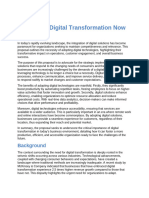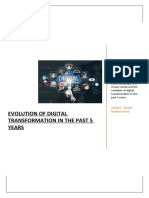What Is Digital Transformation 2023 Overview & Examples
Uploaded by
zaidwwWhat Is Digital Transformation 2023 Overview & Examples
Uploaded by
zaidwwHome » Glossary » Digital Transformation
What Is Digital
Transformation
Explore the section:
Select
Introduction to digital
transformation
Digital transformation as a profound
shift in how an organization operates
and delivers value to its customers.
It’s about leveraging digital technologies to
modify or create new business processes,
culture, and customer experiences.
According to a 2020 report from the
International Data Corporation, global
spending on digital transformation was
predicted to reach $2.3 trillion in 2023
2023,
which indicates the significant importance
businesses worldwide attach to this process.
However, digital transformation isn’t
one-size-fits-all
one-size-fits-all.
The approach varies widely based on the
specific needs, goals, and structure of an
organization. For example, a government
agency might focus on digitizing records and
streamlining citizen services, which could
involve implementing an online platform to
allow residents to pay taxes or renew licenses.
In contrast, an enterprise company might
concentrate on developing digital products,
utilizing cloud computing, or adopting
advanced analytics to improve decision-
making and operations.
In fact, according to a 2019 survey by Gartner,
government CIOs were seen to focus 29% of
their digital services budget on digital
initiatives, such as making government
services available online.
Comparatively, an enterprise company might
put a more significant portion of their budget
into digital customer interfaces and data
analytics.
A 2020 Mckinsey survey found that 85% of
companies accelerated their digitization of
customer interactions due to the Covid-19
pandemic, with 67% increasing automation
and AI investment.
It’s clear from these statistics that every
organization will have a unique journey
towards digital transformation.
The key is to ensure that the transformation
aligns with the organization’s objectives and
adds real value to its customers, stakeholders,
and employees.
[If you’re short on time – watch the digital
transformation video below]:
Digital Transformation Exp…
. In this article, we will explore the concept of
digital transformation in 2023 in more detail,
including its importance for both employees
and customers, its benefits, and how it has
evolved in response to recent challenges,
such as the COVID-19 pandemic, the Russia-
Ukraine war, the “new normal” and the
economic recession.
What is DX? (digital
transformation)
By using “DX” to signify Digital Transformation,
we are drawing on the English language
convention of abbreviating
“transformation” as “X-formation.”
Shortening this phrase has allowed
businesses to quickly and easily
communicate their vision for digital
transformation
transformation.
The term “X-formation” is derived from the
Latin word “trans,” meaning change or
exceed. This connotation of crossing over is
reflected in its shortened version, which
replaced “trans” with an X. Therefore, the ‘X’
denotes transformation as it symbolizes a
journey to something new and improved.
Why Is Digital
Transformation Important?
Before COVID-19 struck, digital transformation
was mainly dedicated to improving customer
service. However, shortly after the pandemic
began, everything changed rapidly, and
digital transformation quickly became a
priority for organizations looking to achieve
operational efficiency and fuel innovation.
With the rapid speed of change in all
industries, CEOs, and CIOs understand the
pressure to stay ahead and recognize it as an
opportunity for their entire organization.
Accelerated digital transformation, such as
cloud computing and data, has become the
primary item on C-Suite agendas since COVID
began.
Organizations that leveraged the right tools
and technologies experienced significant
improvements in customer experience, cost
savings, and agility. This is because digital
transformation allowed them to rapidly shift
their operations, respond quickly to customer
needs, and build efficient workflows that laid
the foundation for growth.
Okta is a perfect example of DX early
adopters.
Kristina Johnson, CPO Okta:
We were early adopters of this digital
transformation journey…We were in a very
fortunate position of what we call a dynamic
work initiative. I refer to dynamic work as
remote work on steroids. It is becoming fully
distributed and really dynamic beyond not
just having people physically located in an
office
The 7 Drivers for Digital
Transformation in 2023
Digital transformation is the process of
leveraging new technologies and digital tools
to improve business outcomes. The 7 main
digital transformation drivers are:
1. New Business Models
2. Enhance Customer Experiences
3. Modernizing IT Infrastructure
4. Operational Efficiency
5. Upgraded Employee Skillset
6. External Partner Collaboration
7. Data-Driven decision-making
Digital adoption is a vital part of digital
transformation, which involves internalizing
and utilizing new technologies and tools by
teams throughout the company.
Organizations can ensure that their digital
transformation initiatives are successful by
training employees, improving processes, and
leveraging data collection methods.
New Business Models – Staying ahead of
the digital curve and developing cutting-edge
products, services, or delivery channels is
essential to any organization’s success.
Moreover, it provides a valuable way for
organizations to compete with their own
existing product lines and offerings.
Enhanced Customer Experiences –
Customers and employees have grown
accustomed to a certain level of convenience
in their day-to-day activities. Whether they
are making purchases online, streaming
videos, or banking on mobile devices – the
same expectations exist when using products,
services, and platforms at work.
Modernizing IT Infrastructure – Even
though legacy IT infrastructure, obsolete
technology applications, and systems
reaching their lifespan have become critical
aspects of daily operations in most
organizations, they remain obstacles to
scalability, support, interoperability, and
growth.
Operational Efficiency – Every branch in
the organization creates its traditional
business procedures for internal and external
interaction as time passes. These operations
often include manual contact, complex
authorization protocols and are likely to
contain manual mistakes.
Upgraded Employee Skillset – Long-term
employees are typically not current on the
latest systems, technologies, or digital
ecosystems. So if any organization wants to
undergo a successful digital transformation
journey, it must invest in upgrading its existing
employee’s skills through seminars, training
sessions, and certifications.
External Partner Collaboration – Strong
integration with various stakeholders such as
partners, vendors, suppliers, and marketing
and delivery channels is essential for a
successful digital business model.
Data-Driven Decision-Making – In a world
of digital systems, data is king. Not only does
this information store records, but it can also
trace the development of operations, report
on what happened in the past and perform
“what if” analysis to anticipate outcomes.
How to enable digital
transformation in 6 steps
Companies understand that digital
transformations are essential to staying
competitive in the current landscape.
Common inquiries range from “What’s the
best way to begin?” “who are the digital
transformation enablers?” and “Where do I
start my journey?” to “How can I acquire
adequate funds for this project?”. To help
organizations on their path of digital
transformation, it’s crucial to find solutions
that fit their budget and strategic goals.
The six steps to enable digital
transformation include:
1. Look at it as a shift in business operations
2. Strategically craft your organizational
transformation
3. Dismantle any obstacles that impede
transformation
4. Foster a mutually beneficial relationship
with your partners
5. Adopt an agile approach
6. Invest for long-term returns
To create real change, follow these six
actionable steps that can help provide
answers to those queries:
Look at it as a shift in business
operations – Companies should make
customers the epicenter of any
transformation they undertake in response to
drastic changes in the market. To ensure
success, start by recognizing potential points
of friction that might arise throughout
equipment sales, parts distribution, and
service provisioning – across industries.
Strategically craft your organizational
transformation – To efficiently achieve
success in any metamorphosis, having a vivid
vision, an amalgamated strategy, and
adherence to value is essential.
Dismantle any obstacles that impede
transformation – Functional silos can be
broken down by concentrating on customer
issues to create an optimal and successful
customer experience. To accomplish this,
different departments must collaborate and
share data.
Foster a mutually beneficial relationship
with your partners – Partnering with other
organizations is a great way to access
innovative solutions. Such collaborations are
also beneficial for forming balanced and
cost-effective partnerships.
Adopt an agile approach – To successfully
achieve transformation, being agile is
essential. It begins by creating a business
environment that fosters experimentation and
encourages innovative thinking to take root
and thrive.
Invest for long-term returns – To
seamlessly fund digital transformation, it is
best to break the process down into easily
achievable steps. To begin with, map out your
organization’s digital opportunities and
requirements across customer touchpoints in
one comprehensive view.
4 main areas of digital
business transformation
So how does digital transformation come into
play in business? It’s not just about adding
technology. Digital business transformation is
about organizational change and learning to
use technology to improve performance.
The use of AMPs (analytical, mobile tools and
applications, and platforms) has exploded
and is completely changing business and
competitive dynamics within many industries.
When it comes to digital transformation,
there are 4 main areas
areas::
1. Process Transformation involves
reworking processes, using APIs, data,
analytics, machine learning, and other
technologies to reinvent corporate
processes.
2. Business Model Transformation is
rethinking and reforming an organization’s
business model to create a more
competitive advantage and achieve
greater profitability.
3. Domain Transformation is changing a
system from one domain to another. It is
often used to change a system from a
physical domain to an abstract domain,
such as a mathematical model.
4. Cultural/Organizational
Transformation is changing a culture or
organization to enhance its effectiveness
and adaptability to new challenges and
opportunities.
Digital transformation by
industry
What are the success rates across sectors
and industries when it comes to digital
transformation initiatives?
Different sectors and industries have their own
unique challenges when it comes to digital
transformation. For some, the challenge may
be in changing entrenched processes. For
others, it may be accessing the resources
needed to implement change.
Let’s take a closer look at how some
major industries are faring with digital
transformation in 2023:
Digital transformation in banking
Digital transformation in banking has been
slow to evolve due to a combination of
security concerns and deep integration of
systems. However, this is changing thanks to
the abundance of cloud-based technologies
and accompanying innovations. Banking will
continue to transform, albeit slower than
some other industries.
Digital transformation in professional
services
Digital transformation is gradually changing
the professional services industry, which
traditionally has prioritized personal know-
how, billable hours, and customer
relationships. The technology revolution
continues to penetrate auditing, accounting,
tax preparation, and advisory sectors; any
reluctance to adopt it will cause a
deterioration in client satisfaction and
adversely impact revenue.
Digital transformation in insurance
Like banking and professional services,
insurance is a more traditional industry and is
slow to adopt change. That means that digital
transformation is a new venture for insurance
companies, having only kicked off in the past
couple of years. According to Gartner, CIOs in
the insurance industry invest 56% of their
budgets on modernizing legacy applications,
reflecting the industry’s preference for
upgrading rather than replacing legacy
systems.
Digital transformation in healthcare
Digital transformation in healthcare has
revolutionized hospitals and patient care,
from AI-based and VR-enabled technologies
to the ability to receive healthcare from
anywhere. It has also created commercial
opportunities for the wearable devices
market, which has skyrocketed in recent
years.
Examples of enterprise
digital transformation
When scaling digital transformation efforts
across an enterprise, we have learned that a
holistic approach works best. The full value of
digital transformation cannot be realized if it
touches only a few mission-critical
applications since such a limited scope
makes it impossible to measure impact
across workflows.
Enterprise digital transformation articles
include advice on how to build cross-
organizational support for digital
transformation initiatives. Leaders must be
clear about value delivery, the role of IT teams
in supporting the initiatives, and a plan to
measure the success of their digital
transformation efforts.
Hey there! Follow me to see
how we can make your
business dreams a reality
Request a Demo
You might also like
- Crafting Succesful Digital Transformations v0.1No ratings yetCrafting Succesful Digital Transformations v0.14 pages
- Digital transformation podcast 16 Oct 23No ratings yetDigital transformation podcast 16 Oct 2310 pages
- Business Analysis and Digital Transformation PDF100% (1)Business Analysis and Digital Transformation PDF8 pages
- Digital Transformation - A Multidisciplinary Reflection and Research AgendaNo ratings yetDigital Transformation - A Multidisciplinary Reflection and Research Agenda6 pages
- Guide To Building A Digital Advantage in IndustryNo ratings yetGuide To Building A Digital Advantage in Industry21 pages
- Digital Transformation Guide Nexus IntegraNo ratings yetDigital Transformation Guide Nexus Integra14 pages
- APC Report Digital Transformation 18 r2 MergedNo ratings yetAPC Report Digital Transformation 18 r2 Merged21 pages
- Latest Digital Transformation Technologies Your Roadmap To SuccessNo ratings yetLatest Digital Transformation Technologies Your Roadmap To Success25 pages
- Digital - Business - Ambition - Transform or Optimize?No ratings yetDigital - Business - Ambition - Transform or Optimize?18 pages
- Destination (Un) Known: Key Steps To Guide Your Digital Transformation Journey100% (2)Destination (Un) Known: Key Steps To Guide Your Digital Transformation Journey16 pages
- Why Are Businesses Experiencing A Digital Transformation - Luka RadovanovicNo ratings yetWhy Are Businesses Experiencing A Digital Transformation - Luka Radovanovic5 pages
- EIS Whitepaper Building A Successful Digital Transformation Roadmap100% (1)EIS Whitepaper Building A Successful Digital Transformation Roadmap11 pages
- Digital Transformation: What It Is, Case Studies & Best PracticesNo ratings yetDigital Transformation: What It Is, Case Studies & Best Practices16 pages
- Creating A Capability-Led IT OrganizationNo ratings yetCreating A Capability-Led IT Organization14 pages
- Accenture Outlook From Analog To Digital How To Transform The Business ModelNo ratings yetAccenture Outlook From Analog To Digital How To Transform The Business Model6 pages
- Closing The Gap: Beyond Digitization To Business TransformationNo ratings yetClosing The Gap: Beyond Digitization To Business Transformation16 pages
- Bae3818 WP What Is Digital TransformationNo ratings yetBae3818 WP What Is Digital Transformation7 pages
- Digitising Finance To Support Business TransformationNo ratings yetDigitising Finance To Support Business Transformation11 pages
- El Camino Hacia Una Transformación Digital Exitosa - 5 Pasos para Hacerlo BienNo ratings yetEl Camino Hacia Una Transformación Digital Exitosa - 5 Pasos para Hacerlo Bien10 pages
- Idc Marketscape: Worldwide Saas and Cloud-Enabled Buy-Side Contract Life-Cycle Management Applications 2021 Vendor AssessmentNo ratings yetIdc Marketscape: Worldwide Saas and Cloud-Enabled Buy-Side Contract Life-Cycle Management Applications 2021 Vendor Assessment11 pages
- Digital Success: A Holistic Approach to Digital Transformation for Enterprises and ManufacturersFrom EverandDigital Success: A Holistic Approach to Digital Transformation for Enterprises and ManufacturersNo ratings yet
- The Digital Enterprise A Framework For Transformation Vol 5No ratings yetThe Digital Enterprise A Framework For Transformation Vol 5124 pages
- A Tool To Map Your Next Digital InitiativeNo ratings yetA Tool To Map Your Next Digital Initiative8 pages
- Digital Transformation Is Not About TechnologyNo ratings yetDigital Transformation Is Not About Technology4 pages
- Tour The Trend - Digital Transformation (DX)No ratings yetTour The Trend - Digital Transformation (DX)1 page
- What Digital' Really Means - McKinsey & CompanyNo ratings yetWhat Digital' Really Means - McKinsey & Company6 pages
- DigitalTransformationinBusinessEnvironmentsChallengesOpportunitiesandBestPracticesNo ratings yetDigitalTransformationinBusinessEnvironmentsChallengesOpportunitiesandBestPractices16 pages
- JD - Nomura Global Markets - BM - IIMK - v3 PDFNo ratings yetJD - Nomura Global Markets - BM - IIMK - v3 PDF3 pages
- IY2593 Managerial Economics: ExaminationNo ratings yetIY2593 Managerial Economics: Examination9 pages
- DBS Group Research Indonesia Property Positive Outlook UnrecognisedNo ratings yetDBS Group Research Indonesia Property Positive Outlook Unrecognised12 pages
- TZ Government Gazette Dated 2017 06 09 No 23No ratings yetTZ Government Gazette Dated 2017 06 09 No 2310 pages
- Operations Management of Tesco Report: Exclusively Available On IvypandaNo ratings yetOperations Management of Tesco Report: Exclusively Available On Ivypanda31 pages

























































































